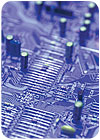
RoHS compliance and lead-free capability: are they the same? Absolutely not. Though many in the industry would say an RoHS-compliant product ensures lead-free process capability, nothing could be further from the truth. RoHS compliance simply means that a product or material does not contain the hazardous substances banned under the legislation. However, just because a material is free of the RoHS list of excluded substances doesn’t mean it can withstand processing at the elevated temperatures of lead-free.
There are countless examples of compliance vs. capability; this article examines surface-mount adhesives (SMAs).
SMA Evolution
Surface-mount adhesives have been a part of assembly for so long they’ve almost become an afterthought. Until recently, these so-called “glues” were expected to perform as required, and they did for the most part. Older generation materials required a fairly high peak cure temperature of 140-150°C. But some components relied upon in the high-volume consumer electronics market - particularly some lower cost components - could not withstand the heat input required for adhesive cure and, thus, reliability was compromised. This led to the engineering of SMAs with lower cure temperatures that used a unique approach so as to enable sufficient cured strength for maximum performance during soldering. Based on these requirements, a new formulation was developed that maintained historical chip bonder properties, yet allowed for a significantly lower cure temperature - as low as 85°C. The combination of lower cure temperature, material strength and reduced rate of temperature rise of these newer generation materials reduced thermal shock and improved reliability, enabling in-line, automated assembly of temperature-sensitive components.Enter Lead-Free
Lower temperature cure adhesives became the industry standard, essentially solving the dilemma of automated processing of temperature-sensitive components and allowing reliable, in-line surface-mount assembly for a range of devices. While there were many benefits of these materials, the advent of lead-free manufacturing pushed them to their performance limits. It soon became clear that yet another adhesive innovation would be required to meet the demands of lead-free process conditions.With years of Pb-free research behind them, materials scientists at Henkel worked to develop an adhesive that maintained low-temperature cure yet could withstand the elevated process temperatures of lead free. Henkel’s next-generation SMA, Loctite®3629, delivers the capabilities of previous low-temperature-cure adhesives, but is capable of retaining its strength during high-temperature soldering processes. The SMA’s advanced formulation maintains the benefits of lower energy input for cure, but also has lower yield points. This enables faster dispensing and printing ability, and results in higher adhesive strength, which can handle the extreme temperatures of lead--free and the pull imposed on components resulting from the greater surface tension of lead-free alloys.
RoHS Compliant and Pb-Free Capable: The Best of Both Worlds
Many SMA suppliers say their “RoHS-compliant” materials are ideal for lead-free manufacturing. But, with several of these products not able to tolerate the higher temperatures, components can pop off of the PCB during reflow due to insufficient adhesion strength.Loctite 3629 provides both RoHS compliance and lead-free capability. Free of the legislation’s banned substances, the SMA meets the stringent criteria and delivers robust performance within a high-temperature environment, all while still imparting lower temperature cure (110°-120°C). Its lead-free capability and low temperature cure also makes Loctite 3629 environmentally friendly, requiring much less energy for processing as compared to competitive materials. Furthermore, its chemistry delivers both long shelf life and an extended floor life, which is particularly beneficial in hot climates because the material maintains its stability even after removal from refrigeration.
The SMA’s advantages are made more profound by its lead-free capability. This material offers the best of both worlds - complete RoHS compliance and lead-free process performance. Remember, these two features are not one and the same.
For more information, e-mail electronics@us.henkel.com or phone (949) 789-2500.